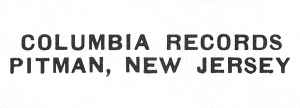A vinyl and cassette manufacturing facility that operated in Pitman, New Jersey from 1961 until 1986, after 1987 as a CD plant under different names until 2011.
History:
Designed by Minoru Yamasaki on a 72-acre site, CBS Inc. (Columbia) officially opened the plant on May 17, 1961 as a high capacity record production facility operated on two shifts by staff of 300 employees managed by Joe Massimino (although the facility actually began limited operations on Oct. 29, 1960, per the booklet that came with The Pitman Family Of Music: Our First 20-Years).
In the fall of 1986, CBS Inc. announced that it would convert the plant to compact disc manufacturing by 1988 and would reach an annual production goal of 20 million units while consolidating its US vinyl record manufacturing business to the Columbia Records Pressing Plant, Carrollton, GA facility.
The Pitman plant produced LP records until December 1986.
Pilot CD production began October 1, 1987 and reached full capacity in January 1988.
In 1988, it became part of the Sony Corporation when Sony acquired CBS Inc.'s music business, renaming the plant Sony Music in 1991 (entry Sony Music, Pitman). By 1997 it joined Sony Disc Manufacturing, Sony ultimately realigned it as a part of the Sony DADC network in the 2000s (entry Sony DADC, Pitman). During this time it grew into a 500,000 square foot complex with a purported average monthly output of 18 million CDs.
Sony DADC closed the facility in early 2011 and migrated the CD manufacturing operations to the DADC, Terre Haute, Indiana facility. At the time of the Pitman plant's closure, its average daily output had decreased to 16,000 CDs.
Pitman vinyl identifiers (see images for examples):
- CPFR;
- Hand-etched "PIT", "CP" or "P" (rather large);
- Stamped P (often very faintly and difficult to find), sometimes misread as "d" as it's at an inverted angle;
- On Capitol Records contract pressings, the number 54 in the runout and a large sized pressing ring (68.5 mm) on the labels;
- On PolyGram contract pressings (labels such as Mercury, Polydor, RSO and Casablanca) the number 56 printed on the labels (1979-80);
- On K-Tel contract pressings the number 16 printed on the labels.
- On A&M Records contract pressings the letter X printed on the labels;
- 2.69685" (68.5 mm) main pressing ring diameter. Sometimes there is a secondary small pressing ring of 14/32" (11 mm).
IDs in runouts for mastering / metalwork done at Pitman but pressed elsewhere:
Pn = mastered at Pitman, pressed at North American Music Industries.
PXS or P XS mastered at Pitman, pressed at Columbia Records Pressing Plant, Santa Maria.
PXT or P XT mastered at Pitman and pressed at Columbia Records Pressing Plant, Terre Haute.
Please do not confuse with the "P AL/BL" code used by Columbia to indicate popular music releases. This P is not a Pitman identifier.
Pitman CD identifiers:
CDs pressed by this plant can be identified by a "CMU P nn(n)" stamp embossed in clear hub. These 2 or 3-digit numbers are not unique, so they should not be added to the Pressed By Catalog Number field. Complete codes should be entered in BaOI as Pressing Plant ID. Example release: Dangerous Toys.
Please only use this label entry for CDs manufactured between 1987-1990. For discs manufactured 1991 or later, use the Sony Music, Pitman label entry instead (also identified by Sony Music copyrights on disc).
Matrix identifiers:
First generation Pitman CDs included an empty mirror band (no matrix text). These were most likely mastered by DADC in 1987.
1988-1990 Pitman masters have matrices in the following patterns:
- [number+letter] [labelcat#] [2-digit number] (used 1988-1989, rarely in 1990)
(example matrix 1A CK40880 01)
- [number+letter] [labelcat#] H1 or H2 (used rarely in 1990)
(example matrix 1AMCD10025 H1)
- [number+letter] [labelcat#] [2-digit number] A or B (used in 1990)
(example matrix 1A EK46063 01 A, 1B CK46772 03 B)
2-digit number is the plant master number (01=first, 02=second, 03=third, etc.)
Please note that letter B was also used after 1990 by Sony Music, Pitman.
Miscellaneous:
Customatrix, a division of CBS Inc.'s Columbia vinyl record manufacturing operations, handled the making of metal parts (e.g. mothers, stampers) for many pressings by Columbia's plants, including those used at the Pitman facility. However, parts from other companies, such as Longwear Plating were also used.
Apart from Columbia/CBS house labels, the Pitman plant is know to have pressed for (amongst others) PolyGram, ECM Records (when under distribution by Polydor), A&M Records, ATCO Records, ABC Records, White Whale
K-Tel, Gordy, Blue Thumb Records, CTI Records, Original Sound, Vanguard.
From April 2 until May 17, 1978, the Pitman plant was hit by a strike by the Teamsters Union. During this period, Columbia shifted pressing activity to its other plants (Columbia Records Pressing Plant, Terre Haute and Columbia Records Pressing Plant, Santa Maria), plus subcontracting key album and/or single pressings to the following plants:
- Goldisc Recording Products, Inc.
- Keel Mfg. Corp.
- MCA Pressing Plant, Gloversville
- MCA Pressing Plant, Pinckneyville
- Monarch Record Mfg. Co. (for 45 releases)
- North American Music Industries
- Peter Pan Industries
- RCA Records Pressing Plant, Indianapolis
Note that some releases in the mid-1980s have a ⎊ (upside down triangle in a circle) symbol on record labels. This mark, which helps designate the A-side of LPs or 12" singles, also appearing on some CDs and cassette tapes, is found on Pitman and Columbia Records Pressing Plant, Carrollton, GA pressings.
